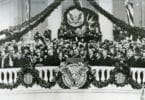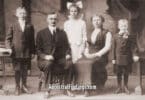Early Life and Background
Chester Alan Arthur was born in Fairfield, Vermont, on October 5, 1829. He was the fifth of nine children born to William Arthur, a Baptist minister and abolitionist from Ireland, and Malvina Stone Arthur, originally from New Hampshire. The family moved frequently due to William Arthur’s various pastoral assignments, eventually settling in upstate New York.
Arthur’s early education took place in common schools and academies in New York. He attended Union College in Schenectady, New York, where he graduated with honors in 1848. After college, Arthur taught school for a few years while studying law. He was admitted to the bar in 1854 and began practicing law in New York City.
Early Career and Marriage
Arthur’s legal career quickly gained traction, and he became involved in several high-profile civil rights cases. One of his notable achievements was his successful defense of African American civil rights in the case of Elizabeth Jennings Graham, who was forcibly removed from a whites-only streetcar in New York City. Arthur’s victory helped pave the way for the desegregation of public transportation in the city.
In 1859, Arthur married Ellen “Nell” Herndon, the daughter of a naval officer. The couple had three children: William, Chester Alan Jr., and Ellen. Ellen, known for her charm and social grace, played a significant role in Arthur’s personal and social life. Sadly, she passed away from pneumonia in 1880 before Arthur became president.
Political Involvement
Arthur’s political career began with his involvement in the Republican Party. He served as a member of the New York State Militia during the Civil War, eventually becoming quartermaster general. In this role, he was responsible for organizing and equipping New York’s troops, earning a reputation for efficiency and integrity.
After the war, Arthur became active in New York politics, aligning himself with the Stalwart faction of the Republican Party, which was led by Senator Roscoe Conkling. He was appointed to the prestigious position of Collector of the Port of New York in 1871, a role that made him one of the most powerful political figures in the state. However, his tenure was marked by accusations of corruption and patronage, leading to his removal from office by President Rutherford B. Hayes in 1878 as part of civil service reform efforts.
Vice Presidency and Ascension to the Presidency
In 1880, Arthur was chosen as the vice-presidential candidate on the Republican ticket alongside James A. Garfield. The Garfield-Arthur ticket won the election, and Arthur assumed the vice presidency. However, his time as vice president was short-lived. Following President Garfield’s assassination in July 1881, Arthur was sworn in as the twenty-first President of the United States on September 20, 1881.
Presidency (1881-1885)
Civil Service Reform
One of the most significant achievements of Arthur’s presidency was his support for civil service reform. Despite his previous involvement in the patronage system, Arthur recognized the need for change. In 1883, he signed the Pendleton Civil Service Reform Act into law, which established the Civil Service Commission and introduced a merit-based system for federal employment. The act marked a major shift away from the patronage system and laid the foundation for modern civil service.
Economic and Domestic Policies
Arthur’s presidency saw efforts to modernize the U.S. Navy, which had been neglected after the Civil War. He advocated for the construction of new steel-hulled ships, leading to the development of a more modern and capable naval force. This initiative helped position the United States as a growing naval power.
On the economic front, Arthur supported tariff reform and the reduction of excessive tariffs, which were seen as benefiting certain industries at the expense of consumers. He also vetoed the Chinese Exclusion Act of 1882, arguing that it was discriminatory, although Congress overrode his veto.
Foreign Policy
Arthur’s foreign policy initiatives included efforts to strengthen diplomatic relations with Latin American countries and promote trade. He supported the construction of a canal across Central America to facilitate maritime trade, although the project did not come to fruition during his presidency.
Personal Life and Character
Arthur was known for his refined taste and attention to detail, which extended to his personal appearance and lifestyle. He was an avid collector of fine art and antiques, and he oversaw significant renovations to the White House, including the addition of an elevator and modern plumbing.
Despite his reputation as a political machine insider, Arthur demonstrated a capacity for growth and change during his presidency. His commitment to civil service reform and efforts to modernize the Navy reflected a pragmatic and forward-thinking approach to governance.
Health and Later Life
Arthur’s health began to decline during his presidency due to a kidney disease known as Bright’s disease. He kept his condition private and continued to fulfill his duties, but the illness took a toll on his stamina and energy. After leaving office in 1885, Arthur retired to New York City. He passed away on November 18, 1886, at the age of 57.
Legacy and Impact
Chester A. Arthur’s presidency is often viewed as a turning point in American politics, particularly with regard to civil service reform. His support for the Pendleton Act helped to curb corruption and patronage, setting the stage for a more professional and merit-based federal workforce.
Arthur’s efforts to modernize the navy also had a lasting impact, contributing to the United States’ emergence as a naval power in the late 19th and early 20th centuries. His ability to transcend his political roots and embrace reform earned him respect and recognition as a president who rose to the challenges of his time.
Interesting Aspects of Arthur’s Presidency
Renovation of the White House
Arthur’s interest in art and architecture led to significant renovations of the White House. He hired renowned designer Louis Comfort Tiffany to redecorate several rooms, including the East Room and the State Dining Room. These renovations reflected Arthur’s refined taste and brought a sense of modern elegance to the executive mansion.
The Star Route Scandal
Arthur’s presidency was also marked by the Star Route scandal, a corruption case involving fraudulent postal contracts. Although Arthur was not personally implicated, the scandal highlighted ongoing issues with government corruption and underscored the need for further reforms.
Conclusion
Chester A. Arthur’s life and presidency offer a compelling story of transformation and reform. From his early career as a lawyer and political insider to his unexpected rise to the presidency, Arthur’s journey is a testament to his adaptability and commitment to public service.
While his presidency faced challenges and controversies, Arthur’s support for civil service reform and efforts to modernize the navy left a lasting legacy. His ability to embrace change and address the needs of the nation reflected a pragmatic and forward-thinking approach to leadership.
Arthur’s story serves as an enduring reminder of the importance of integrity, reform, and adaptability in the pursuit of effective governance.
If you’d like to learn more about this President, here are a few Recommended Books on Chester A. Arthur.
“Gentleman Boss: The Life of Chester Alan Arthur” by Thomas C. Reeves
This comprehensive biography by Thomas C. Reeves offers a detailed and balanced account of Arthur’s life, from his early years and political career to his presidency and beyond.
Part of The American Presidents Series, this concise biography by Zachary Karabell provides an accessible overview of Arthur’s life and presidency, highlighting his significant achievements and challenges.
“The Unexpected President: The Life and Times of Chester A. Arthur” by Scott S. Greenberger
Scott S. Greenberger’s book delves into Arthur’s life, unexpected rise to the presidency, and impact on American politics and governance.
“Chester A. Arthur: A Quarter-Century of Machine Politics” by George F. Howe
This book examines Arthur’s political career and the machine politics of his era, providing context for his presidency and reforms.
“President Chester Alan Arthur: His Life and Times” by Gregory J. Dehler
Gregory J. Dehler’s biography comprehensively examines Arthur’s life, including his early career, presidency, and legacy.






